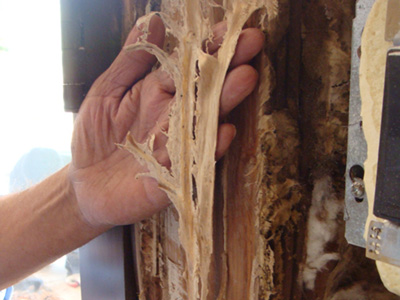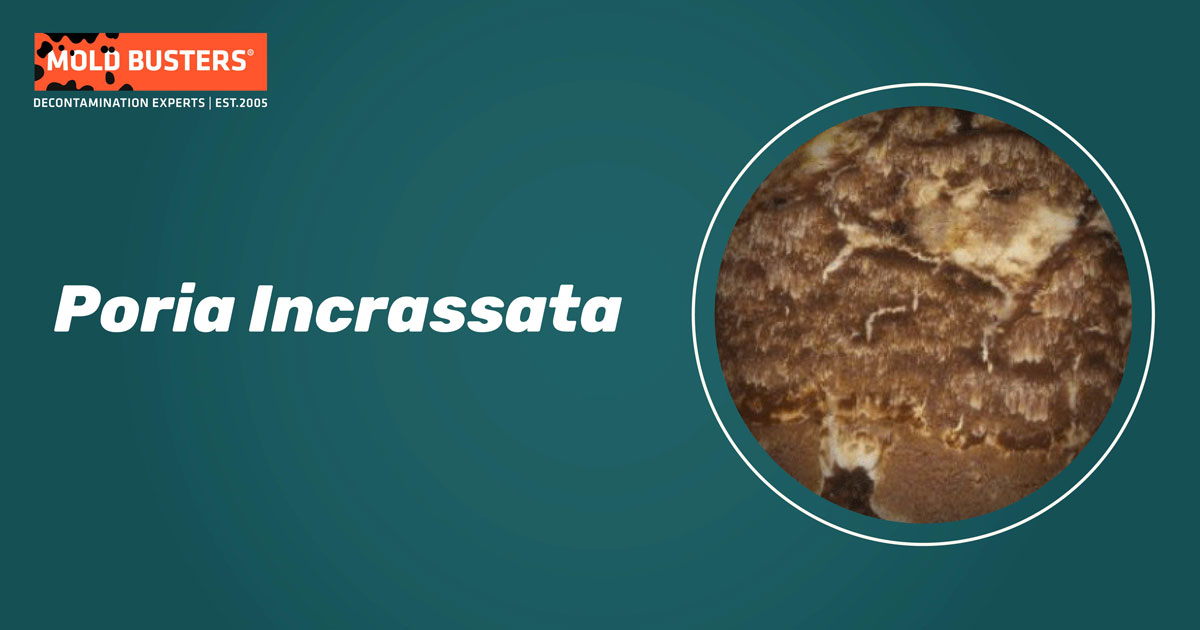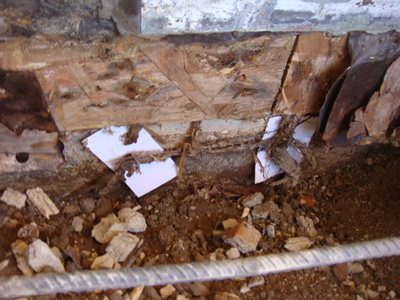(Berk. & M.A. Curtis) Burt 1917
(syn. Meruliporia incrassata (Berk. & M.A. Curtis) Murrill)
What is Poria incrassata?
Poria incrassata (current name: Meruliporia incrassata). is a fungus that causes extensive brown wood rot. This fungus invades wood, digests the cellulose component, and uses sugar as a nutrient. The infected wood loses its mechanical properties and its structural capabilities. P. incrassata is also known as a “water-conducting fungus”, as it can transfer water 30 feet or more away from the original moisture source via structures called rhizomorphs. [1,2]. Furthermore, its rhizomorphs are capable of transporting water at speeds of almost 5 meters per hour [4] (Fig. 1).

What causes Poria incrassata?
P. incrassata has mostly been reported in buildings located in coastal areas of North America, particularly in the Southeastern United States. It develops optimally at temperatures between 24-30°C (75–86°F) and does not tolerate temperatures above 35°C [2]. High humidity is one of the major factors of Poriadevelopment. Therefore, if you live in the vicinity of a body of water you might want to check your home for Poria incrassata.
Infections readily occur when wood material comes in contact with soil, or when siding goes below the soil grade. Inadequate ventilation of crawl spaces, or poor soil to wood clearance can also cause infection. This fungus will also use any cracks in the perimeter foundation to grow its rhizomorphs and get to the nearest water supply [3].

Where can you find Poria Incrassata mold in your home?
Buildings infections of Poria incrassata typically start in basements or crawl spaces where wooden construction material is in close contact with the soil, moist concrete, or bricks. At first, papery mycelial fans, whitish with a yellow tinge, grow over the surface of moist wood, or more commonly between sub-and finish floors, between joists and subfloors, or in other secluded areas. If there is a sufficient supply of water, the mycelium spreads rapidly for distances up to 10 meters, destroying framing, sheathing, paneling, flooring, and other cellulosic materials [2] (Fig. 2).

Irregular vine-like rhizomorphs branching into the soil or extending to some other constant supply of water may appear on foundations, framing, or the underside of the flooring. Damage has been reported to cupboards, wardrobes, documents, and building papers. Infections can also spread to carpets, linoleum, oilcloth, canvas, and cellulosic electrical conduits and insulation [2].
P. incrassata can attack the lumber of several species of tree. It is known to develop on southern pine, ponderosa pine, eastern white pine, Austrian pine, Virginia pine, Douglas-fir, western red cedar, redwood, cypress, juniper, white fir, hemlock, oak, red gum, magnolia, and maple [2].
Is Poria Incrassata dangerous to humans and animals?
No information is currently available regarding the health effects, toxicity, or allergenicity of P. incrassata. However, as a water-conducting fungus, Poria incrassata dampens the wood structure of your home, making the environment habitable for other molds that are known to be dangerous, such as Aspergillus, Alternaria, Chaetomium, Cladosporium, and many others. Mold spores, no matter the species, are a health hazard as they act as allergens when ingested, especially during prolonged exposure. They can cause relatively benign symptoms such as a sore throat, skin rashes, or irritation of the nose and eyes. However, immunocompromised or sensitive individuals can succumb to serious mold-related diseases which can be fatal in extreme cases.
How to identify Poria Incrassata?
Most obvious indicator of Poria incrassata in the home is the presence of rhizomorphs. Rhizomorphs resemble plant roots and give away an earthy or “mushroomy” smell when they are cut open. They turn brown to black with age and are usually 1-2 cm (0.4–0.8 inches) thick (some can reach up to 5 cm (2 inches)) [2].
In severely rotted wood, fruiting bodies may be observed. They are succulent, flat, up to 1 cm thick, and pale olive-gray, with a dirty white to pale yellow margin when young. When mature they become dry and brown to black. Its spore-bearing surface (hymenium) is covered with fine pores.
How to remove Poria Incrassata?
There are several ways to remove and stop the spread of Poria incrassata. As the species is very sensitive to dry conditions, the first step is to locate its water source and cut off its supply. This could be a leaky pipe, a puddle, or simply the moist soil around the house. In cases when the fungus has developed due to poor construction, it is often feasible to install proper hydro-isolation, thus cutting off the rhizomorphs from the water supply.
Rhizopores and any other fungal growth should be removed by hand or scraped off the foundation using a metal brush. Infected areas should be dried out thoroughly and infected wood should be replaced. Furthermore, pressure-treated wood should be used, especially in humid areas which are more prone to fungus spread. Also, any contact between wood and soil should be prevented. Problem areas can be dirt-filled porches or terraces; forms left under concrete steps or on foundations; or stumps, debris, or other wood that makes a direct bridge from the soil to the house [2].
In any case, removing a Poria infestation is not a “do-it-yourself” job. It is difficult to estimate the true extent of the fungus spread because the true body of the mold lives inside the substrate it feeds on. Furthermore, considering dangerous chemicals and the fumes you might come into the contact with, it is best to turn for professional help.
How to prevent Poria Incrassata?
Most methods to prevent P. incrassata development are related to the construction phase. These practices include the use of dry, uninfected lumber and control of soil moisture by proper grading of building sites so that surface water drains away from the foundation. Furthermore, all forms and grade stakes should be removed along with any wood debris and stumps under the building. Crawl spaces and basements should be constructed in a way that they are kept dry, and dirt-filled porches and terraces should be avoided.
Practices that should be avoided include the building of flowerbeds where the soil touches siding, wetting wooden walls when sprinkling lawns, letting plumbing leak for long periods, allowing downspouts to become clogged, and piling wood or other cellulose material inside the crawl space or against the side of the house [2].
If you suspect Poria in your home, don’t hesitate and call a professional mold removal service like Mold Busters immediately. The earlier Poria is caught the better. We offer comprehensive mold testing and removal services and will be able to tell you with certainty whether the mold in your house is Poria or not. Call us today to book an appointment!
Conclusion
The damage that Poria Incrassata can cause to buildings is massive. It is a frightening fungus that invades and destroys the strength and structural integrity of buildings and wood components. In most cases, it is only caught after a few years of development and the damage caused by it is usually extensive and requires substantial repairs.
If you suspect Poria in your home, don’t hesitate and call a professional mold removal service like Mold Busters immediately. The earlier Poria is caught the better. We offer comprehensive mold testing and removal services and will be able to tell you with certainty whether the mold in your house is Poria or not. Call us today to book an appointment!

Did you know?
Basements in Canada are the most affected by the Penicillium/Aspergillus mold group?! Find out more exciting mold stats and facts inside our mold statistics page.
References
- Quarles SL (2019). Fungal Damage in Buildings with Emphasis on Meruliporia ‘poria’ incrassate. Retrieved from: ucanr.edu
- Verall AF (1968). Poria Incrassatarot: Prevention and Control in Buildings. Technical Bulletin No. 1385, U.S. Department of Agriculture, Forest Service. Washington, D.C.
- Earle JC (2014). The Wood Eating Fungus “Poria” is in Southern California! Retrieved from: ecjlaw.com
- Friedman D (2018). Meruliporia incrassata – “Poria” the house eating fungus & Serpula lacrymans: infamous wood rotters. Retrieved from: inspectapedia.com

Get Special Gift: Industry-Standard Mold Removal Guidelines
Download the industry-standard guidelines that Mold Busters use in their own mold removal services, including news, tips and special offers:

Written by:
John Ward
Account Executive
Mold Busters
Edited by:
Dusan Sadikovic
Mycologist – MSc, PhD
Mold Busters
